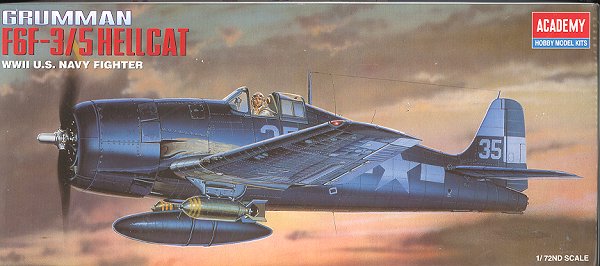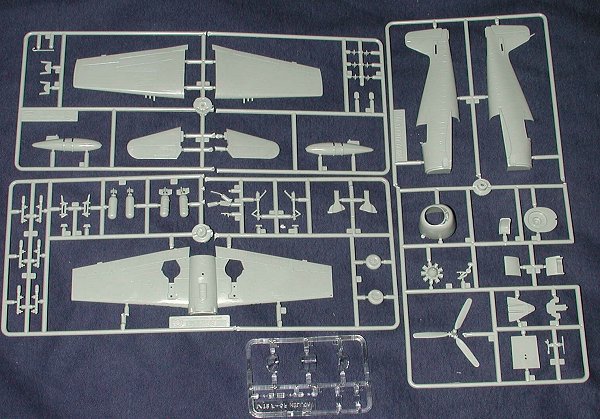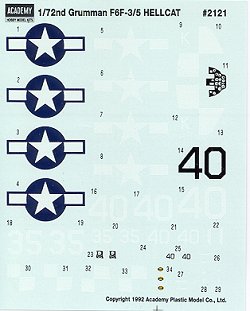
|
KIT: |
Academy 1/72 F6F Hellcat |
|
KIT # |
2121 |
|
PRICE: |
$8.00 MSRP |
|
DECALS: |
Two aircraft |
|
REVIEWER: |
|
|
NOTES: |

|
HISTORY |
What aircraft shot down more Japanese aircraft than any other: the Hellcat. What plane was easy to fly, and maneuverable: the Hellcat. What Navy aircraft was built in larger numbers than any other during WWII: the Hellcat. What plane was quickly pulled from squadron service and scrapped in huge numbers after the war: the Hellcat.
Grumman's F6F was a stroke of pure genius and one that was sorely needed. True, the Wildcat could hold its own, but it was outclassed by the A6M. Something with more power, longer range and greater maneuverability was needed and that aircraft was the F6F. Its gestation was relatively trouble-free as new aircraft go with minimal problems. The design was also basically the same throughout its short service life, so a pilot learning on a F6F-3 could step into a -5 and feel right at home. Updates to the -5 included a bit more power from the engine and the ability to carry rockets on the wings. Though there is more to it than that, those are the salient features.
Pilots who flew the plane loved it. It had almost no vices and could be well flown by even nuggets. A far cry from the rather squirrelly and difficult to handle Corsair. Unfortunately, there was little room in the post war Navy for the faithful Hellcat. Though some soldiered on in the reserves and others were used as radio controlled drones, the jet age was the coming thing and the Hellcat faded from memory. A few are still around as warbirds and museum pieces.
|
THE KIT |

I've probably mentioned before that Academy has a tendency to reverse engineer other folks kits and those one looks somewhat like a Hasegawa kit. One major difference is that this kit has the underwing rockets for the F6F-5 version.
 The kit is very nicely molded with
properly engraved detail. The cockpit has more detail than the Hasegawa version,
offering inner panels that the Japanese kit doesn't. There are also options to
allow the modeler to build either the -3 or the -5 version from the kit. These
include different windscreens and other minor bits and pieces. A nice
touch is that the canopy and windscreen are separate. Whether that means you can
have the canopy open is unknown as the clear bits are a touch thick. There
is an option to have the tail hook extended, but really, you would rarely see it
like that on the ground. It would have been nice to have a folded wing option,
but perhaps some time later a resin mfg will do us the honors.
The kit is very nicely molded with
properly engraved detail. The cockpit has more detail than the Hasegawa version,
offering inner panels that the Japanese kit doesn't. There are also options to
allow the modeler to build either the -3 or the -5 version from the kit. These
include different windscreens and other minor bits and pieces. A nice
touch is that the canopy and windscreen are separate. Whether that means you can
have the canopy open is unknown as the clear bits are a touch thick. There
is an option to have the tail hook extended, but really, you would rarely see it
like that on the ground. It would have been nice to have a folded wing option,
but perhaps some time later a resin mfg will do us the honors.
The instruction sheet is more than adequate offering color information with each of the various construction steps. My copy is direct from Korea so much of this is in Korean, however it is not an insurmountable obstacle! There are two markings options provided. One is an F6F-3 in the tri-color scheme from VF-1 aboard the USS Yorktown. The other is an F6F-5 from VF-17 aboard the USS Hornet and in an overall gloss sea blue color. Academy's decals are quite gloss and generally work rather well. Not sure exactly how opaque the white parts are so it may be a good idea to have an aftermarket sheet for a backup if so needed.
|
CONCLUSIONS |
Overall, it is a kit that I have seen built up and it looks very nice when done. Were I to have to choose between a $16.98 Hasegawa kit and the $8.00 Academy, the Korean kit would get the nod.
Review kit courtesy of my kit collection.
If you would like your product reviewed fairly and quickly by a site that has well over 100,000 visitors a month, please contact me or see other details in the Note to Contributors.